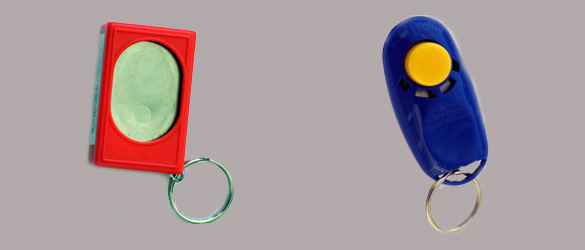“What is ‘clicker training’ anyway?! I think I’ve heard of it someplace….” If you’ve asked that question, it’s time we talk about the hottest thing in positive reinforcement training. Clicker training is an example of “operant conditioning,” a way in which the animal figures out how to operate in the space or the environment in order to earn a reward or resource. It works more efficiently than humans intervening, jerking and tugging an animal into a desired position, to satisfy human desires for behavior. Karen Pryor is the recognized pioneer of clicker training, as she began using it in the 1960s with dolphins. You can’t strong-arm a dolphin into position physically (sound familiar, greyhound owners?!). Using operant conditioning techniques and positive reinforcement, Karen was able to teach these huge marine mammals which behaviors will be reinforced, and which ones will not earn rewards. This knowledge was then expanded to all animals, and it works especially well with dogs.
There are many different theories about animal training and learning theory. Some are good, based upon fact and science, and some are bad, as they’re based upon conjecture and anthropomorphic interpretations of the way animals learn. Clicker training is definitely one of the more effective techniques we have to use while learning how to communicate with our dogs. At the heart of clicker training is the concept of a conditioned reinforcer. When we consistently pair the sound of a clicker with a reward (food, toy, etc.), we create a conditioned reinforcer. What’s so magic about the click itself? I have clients ask me, “Can’t I just make a clucking sound or say ‘yes’ or something like that?” The answer is yes, you can, but it won’t be as efficient, and is potentially less effective. The great thing about the clicker is that the sound is pure and exact every single time. It marks the exact second that the dog behaves in a way that earns a reward.
As humans, we send a jumbled mess of signals to our animals all day long, both physically and verbally. It’s remarkable how skilled dogs are at the subtle interpretations of those often inconsistent signals. Suffice it to say that the more consistent the sound (click), the more efficient the learning. You may inadvertently use some degree of emotion when you say the word “Yes!,” either positive or negative based on how the dog performed, which could be detrimental to the message you are trying to convey. With the click sound, the message is clear every single time and devoid of distracting emotion. If the dog does not do the behavior you are looking for, then the consequence is that no click and no reinforcer appear. What you get with a “clicker-wise” dog is a bridge between the two cultures: You effectively have a human-canine dictionary comprised of yes/no data. That can be REALLY useful!
With clicker training the learning is fast and deep. Learning theorists continue to analyze why behaviors learned via operant conditioning stick so well. Is this type of learning stored in a different part of the brain than learning by rote? With clicker training or operant conditioning training, you can teach your dog behaviors effortlessly, in short 3 – 5 minute sessions daily. With more conventional teaching by repetition (20 minute sessions daily), dogs can lose what they’ve learned if you don’t continue to practice the behaviors. I taught my greyhound Corsa to touch a target stick (the very tip ONLY) using a clicker, and then put the target stick away for months. Anytime I bring it out, she will touch just the very tip, wagging her tail happily and loving her success! (She’s so cute!)
This brings up my next point. Clicker training is FUN! Dogs love it and humans love it! It works for confident and shy dogs alike. Clicker training with shy dogs is really wonderful because once the shy dog learns that he or she can win at something, and get rewarded for it, the dog gains confidence and becomes less shy by being able to bring more predictability to his or her world. We all like to know what happens next!
I have seen some well-intentioned people try to use a clicker like a remote control. This is rather comical! They point it at the dog and shout “sit!” while they click feverishly. Of course, this does not work and is not how the technique works. Once the clicker has been “installed,” or reliably paired with the reinforcer, we use the clicker to mark a desired behavior as it is happening–it does not solicit for one. Once the animal repeats the desired behavior 8 out of 10 times or so, we can then attach a verbal cue to it and begin to fade the clicker. The fun part of clicker training in the beginning, is that it’s a silent effort. You silently watch the learning occur and click to mark the thing you want repeated. There is definitely a right way and a wrong way to go about teaching with a clicker, so be sure to view the resources listed at the end of this article if you are interested in pursuing this kind of training.
Clicker training is so positive it also enhances your relationship with your dog. As I’ve said before in other columns, gone are the days of committing violence against our animals in the name of “training.” There is another way! Dogs love to think and be engaged in a game. Clicker training is a fun game for them and it helps to bond you together. Any aversive stimulus, collar, etc., needs to be excluded from the clicker training process completely. It’s 100% positive all of the time.
As a professional trainer, I recognize that clicker training may not be for every family. It can be difficult to juggle your dog, leash, treat pouch, clicker, etc… while focusing on clicking accurately. Conventional lure and reward training is positive and works too, if you practice a lot and stay consistent. However, if you are looking for a whole new way to communicate with your dog and you haven’t tried clicker training yet, I highly recommend that you do! Clicker training is a useful, fun, and effective endeavor for you and your dog that can benefit both of you for life!
For more information on clicker training check out these resources: Clicker Training for Dogs, Karen Pryor; Don’t Shoot the Dog! The New Art of Teaching and Training; Karen Pryor; Click to Calm, Healing the Aggressive Dog, Emma Parsons; Clicking with Your Dog, Peggy Tillman;Clicker Training for Obedience, Morgan Spector; www.clickertraining.com
Genie Tuttle, CPDT-KA has been training dogs of all breeds for over 25 years and a greyhound owner for over 15 years. She is presently owned by Corsa and Manx! She has earned the Certified Professional Dog Trainer (CPDT-KA) credential, the first independently issued credential for dog training. This credential requires regular attendance at ongoing education, exposure to progressive positive methods, and testing. She is a member of the Association of Professional Dog Trainers (APDT). Genie can be reached at genie@doggenie.com. www.doggenie.com
Published in the October 2007 edition of Greyt Times newsletter, the official publication of the Homestretch Greyhound Rescue and Adoption.
Using a Clicker
The clicker is like a human:canine dictionary
A “Click!” is ALWAYS followed by a treat
“Click!” one time only
“Click!” during the behavior (not before, not after)
Lure or wait for the desired behavior, then click as it happens!
Keep Clicker sessions short like 3 – 5 mins each
Click the behavior you want as it is happening
Do not use the clicker to get attention or to prompt
It is for marking a desired behavior only
When your dog is offering the behavior right (80% of the time) add
a verbal Cue just prior to the behavior
• Clicker training is a FUN way to communicate with your dog!

